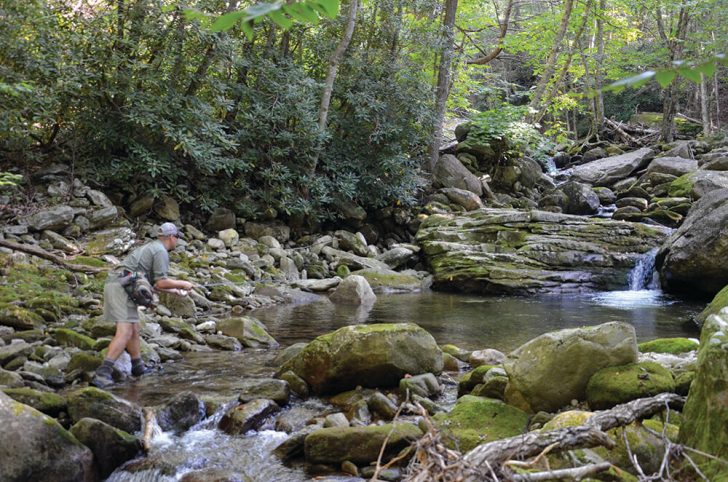While rock hopping and prospecting with dry flies for brightly colored brown trout, it’s easy to imagine the upper end of Wilson Creek as it was more than 250 years ago.
But the forest is younger than it was when Native Americans likely pulled native brook trout from the creek. Logging began in the 1750s when pioneers settled this remote area of western North Carolina’s Caldwell County. For nearly two centuries a timber operation and the communities that grew around it thrived in the shadow of Grandfather Mountain.
Mortimer was the largest settlement on Wilson Creek. It was home to the Ritter Lumber Mill Company sawmill as well as a small textile mill. The ruins of Mortimer lie near what is now a stretch of prime trout water.
The story of Mortimer is one of nature reclaiming itself. Beginning in 1916, and probably exacerbated by the clearance of the land, a series of fires and floods twice destroyed the narrow-gauge railroad used to haul out timber. A final massive flood in 1940 swept away both the sawmill and the textile mill, and without industry, the surviving residents abandoned their homes.
Since that time, a good portion of Wilson Creek’s more than 23-mile corridor from its headwaters on Grandfather Mountain down to its confluence with Johns River has regenerated to a mostly wild state. In 2000, the stream was designated a National Wild and Scenic River, which provides special ecological protections.
Trout anglers should delight in the transformation. On its upper end, Wilson Creek plummets cold and clear as a small to medium sized stream through a steep wooded valley on Pisgah Game Lands. There is access by foot to miles of creek that offer anglers one waterfall and plunge pool after the next. Small but bright stream-born brown trout dominate the fishery. In this stretch it is managed under catch-and-release, artificial-only regulations.
Downstream, after flowing through roughly 4-miles of private property, Wilson Creek emerges again to the public as a larger flow. The mouth of Lost Cove Creek is the upper boundary of delayed harvest waters. October into June each year, this beautiful 3-mile stretch is managed under catch-and-release, single-hook, artificial-only regulations. The state stocks it heavily.
And for anglers who’d like to keep some trout for the table, Wilson Creek is open under regular hatchery supported trout regulations for another 5 miles down to the remains of an old lowhead dam near the Adako community. This section is big water. It is punctuated by a gorgeous rock gorge.
Wilson Creek Falls from North Carolina’s high country around the towns of Boone, Blowing Rock and Linville. Fishing it would make a good day trip or weekend adventure from Winston-Salem, Asheville or any of the towns on this eastern edge of North Carolina’s Blue Ridge Mountains.
For GPS coordinates to access points and detailed maps of Wilson Creek and all of North Carolina’s and Georgia’s best trout water, check out “Flyfishers Guide to North Carolina & Georgia.” It is available at fly shops, on Amazon, and signed copies are available from the author by emailing nsc8957@gmail.com.
